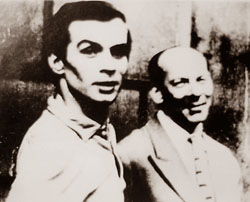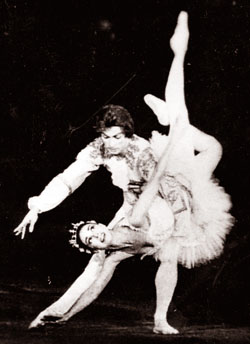Two great Russian icons with same name
Gwen Herat
|

FAMOUS DUO: Alexander Pushkin with his famous teacher in 1956.
|
ART: There were two great Russian artists with the same name, and
with the same interest. One from the world of arts and the other from
the world of literature. Alexander Pushkin (1907-1970) and Alexander
Pushkin (1799-1837) were fiercely Russians who put their country on top
in their chosen fields. One gentle and demure; the other fiery and
explosive in words.
Alexander Pushkin, the ballet teacher who was responsible for
grooming and training great dancers like Semyonov, Makarova, Soloview,
Nureyev, Panov, Baryshnikov etc. was a soft spoken gentle giant who was
a dancer and then a great teacher. He studied at Leningrad Ballet School
and graduated in 1925. He became the best dancer and teacher at the
Choreographic School.
Dedicated to classical ballet, he brought about a mixture of styles
that had prevailed in Russian ballet ever since. He was a devoted
disciple to this cause but he also appreciated the spectacular effects
of the Italian technique and intrigued by its method, never mixing the
two.
To him, Russian classical ballet was pure, immortal and unpolluted
and he kept it that way to the end. However, Pushkin brought about an
emotional intensity and a sensuality in movements, giving his students
the freedom to explore its glow and radiation.
His star pupil, Rudolf Nureyev came in face to face and who was to
change his life and make him the enigma he became around the world.
There was an apt irony in the two Pushkins who guarded either end of the
hall of mirrors that was the life of Nureyev who had not encountered the
works of Alexander Pushkin, Russia’s National poet of the 19 century.
Pushkin the Kirov teacher was the hero of male ballet dancers in the
20th century Russia. A head-on with Pushkin’s literary legacy seemed
inevitable to the young Nureyev and his taste for Pushkin’s literature
grew with the years.
Funeral service
The first words spoken at Nureyev’s funeral service in Paris were an
extract from Pushkin’s Eugene Onegin, Dead at thirty eight in a duel,
the man behind Pushkin’s was clearly every bit as absorbing to an almost
eerie projection of what was to come for Nureyev.
Pushkin’s outspoken objections to the political repression of his era
made him the bane of the Ramonov authorities and as a result became a
social exile. By his own count, the woman Pushkin married and whose
infidelities led to the fatal duel, was his 113th paramour.
Ballets
|

DISCOVERY: Pushkin’s discovery - Rudolf Nureyev - with Margot
Fonteyn.
|
In contrast, Alexander Pushkin whose classes would set fire to
Nureyev’s dancing, was a man famous for never raising his voice. He was
gentle to the word and his students as well as colleagues marvelled at
his modesty. Teaching the Kirov style Pushkin made spectacular dances
from beginners. When Nureyev came under him, Pushkin at once spotted the
brilliance that lay in the boy but he was wild and crazy.
With time, he was able to tame and for this purpose, took him and
allowed him the freedom to move about in his home. Nureyev went crazy,
dancing on top of tables, leaping from windows, crawling under tables
and all the while, Pushkin knew, these were the advent to greatness.
After unravelling the creative elegance in dancers, Pushkin watched
their progress with awe on the supreme eloquence. Kirov and he became
inseparable until his death.
Pushkin (writer/poet) amazingly inspired leading choreographers to
mount ballets even during his lifetime. Adam Ghushkowky gave the
precedence when he opted to choreograph Ruslan and Ludumila in 1821 in
Moscow which was 16 years before the poet died.
He was followed by Didolet who in 1923 mounted The Prisnor of the
Caucaus in 1823. The first ballet to go on board after his death was The
Goldfish by Sainte Leon in St. Petersbug in 1867. Nijinsky could not
resist doing his own thing when based on The Fountain of Bakhesaray, he
choreographed the ballet The Victim of Jealousy in 1892 at the Kiev. A
number of Pushkin Ballets were produced in the USSR. eg:
The Fountain of Bakhesaray by Zakharov in 1934
The Prisoner of the Causeaus by Lavrovsky in 1938.
The Aristocratic Peasent Giri by Zakharov in 1946.
The Bronze Horseman by Zakharov in 1949.
The fake of a Priest and his Labourer, Balda by Vasakovisky in 1940.
The Gypsies by Kholfin in 1937.
The Princess and the Seven knights by Andrelev and Fenster in 1949.
Fate
There were many ballets produced outside Russia and they included
Aleko choreographed by Massine to the music of Tchaikovsoky in 1942 at
the Ballet Theatre in New York. La Dame De Pique was yet another
successful ballet to the music of Tchaikovsky by Lifar while John Crank
choreographed Onegin again electing the scores of Tchaikovsky in 1960 in
Monte Carlo.
And in 1975, Prokiev’s scores were used for Tsar Boris mounted by
Boyarichikov. Apart from all these literary works of Pushkin, many
choreographers also adopted his poems to do excerpts in ballet. Even the
Grand Ballet du Marquis Cuevas in Paris mounted several of Pushkin’s
literary gems in 1951.
Regarded as a Founder of Russian literature, Alexander Pushkin born
to a less privileged family, started off wrong by being critical of the
regime he lived in. Twice he was exciled in 1920 and 1824. Nicholas I
who admired his work and skill at Russian literature and poetry showered
compassion on him and freed him from censorship on his literary
activities.
Always in trouble, this genius who got into argument with his wife’s
paramour, was killed. With a sense of telepathy looming over his work,
he had recorded something akin to what befell his fate.
Alexander Pushkin stepped on to literature at the age of 15. Most of
his plots and scenario were set in Russia. He wrote novels, poems and
stories. His creative expressions were drawn from folk stories, gypsy
life and human narrative emotionally and sensitively bound by the
culture of his era.
He was an outspoken champion for the poor and the distressed, always
willing to help but with an amorous eye on women, 113 with whom he
slept.
He would have still pursued on this spree if not owing to his early
dismissal of life by a Russian noble. His works are translated into many
languages is Sinhala, Sanskrit, Hindi, Tamil and several Afro-Asian
countries. A great poet, a great writer; he lived by the rule and died
the way he desired for the sake of a woman. |

